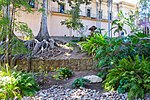Museum of Photographic Arts
1983 establishments in CaliforniaArt museums and galleries in CaliforniaArt museums established in 1983Balboa Park (San Diego)Institutions accredited by the American Alliance of Museums ... and 2 more
Museums in San DiegoPhotography museums and galleries in the United States

The Museum of Photographic Arts (MOPA) is a museum in San Diego's Balboa Park. First founded in 1974, MOPA opened in 1983. MOPA is one of three museums in the US dedicated exclusively to the collection and preservation of photography, with a mission to inspire, educate and engage the broadest possible audience through the presentation, collection, and preservation of photography, film and video. The museum's address is 1649 El Prado, San Diego, CA, 92101.
Excerpt from the Wikipedia article Museum of Photographic Arts (License: CC BY-SA 3.0, Authors, Images).Museum of Photographic Arts
El Prado, San Diego Banker's Hill
Geographical coordinates (GPS) Address Nearby Places Show on map
Geographical coordinates (GPS)
| Latitude | Longitude |
|---|---|
| N 32.731 ° | E -117.149 ° |
Address
Casa de Balboa Building
El Prado
92134 San Diego, Banker's Hill
California, United States
Open on Google Maps











